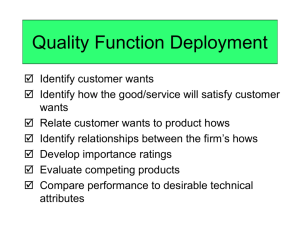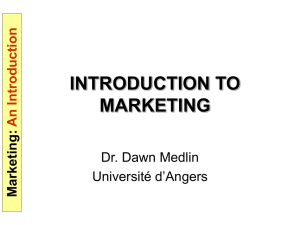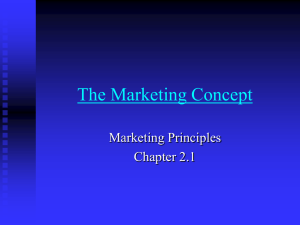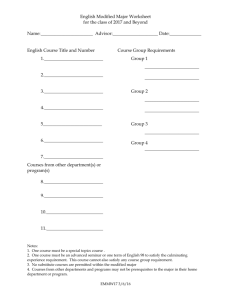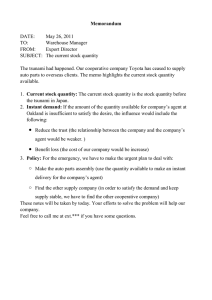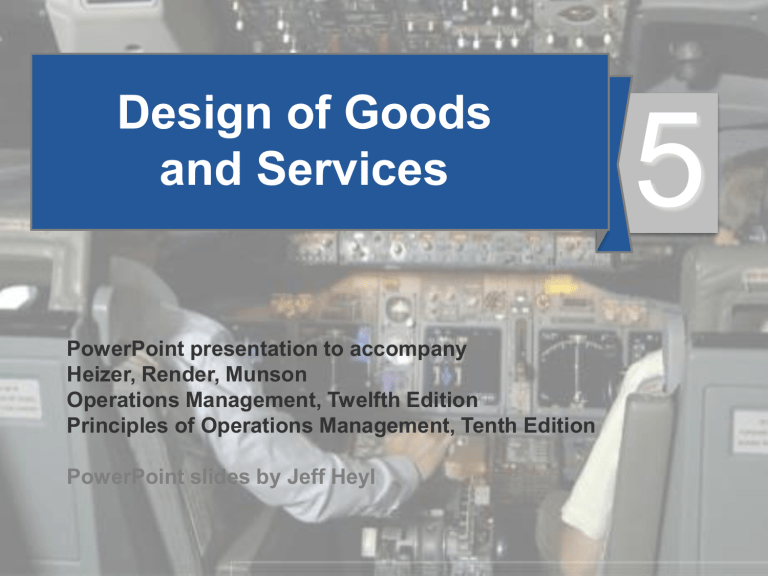
Design of Goods and Services PowerPoint presentation to accompany Heizer, Render, Munson Operations Management, Twelfth Edition Principles of Operations Management, Tenth Edition PowerPoint slides by Jeff Heyl 5 Outline ► Global Company Profile: Regal Marine ► Goods and Services Selection Generating New Products Product Development Issues for Product Design Product Development Continuum ► ► ► ► Outline - Continued ► ► ► ► ► Defining a Product Documents for Production Service Design Application of Decision Trees to Product Design Transition to Production Regal Marine Global market ► 3-dimensional CAD system ► ► Reduced product development time ► Reduced problems with tooling ► Reduced problems in production Assembly line production ► JIT ► Learning Objectives When you complete this chapter you should be able to : 5.1 Define product life cycle 5.2 Describe a product development system 5.3 Build a house of quality 5.4 Explain how time-based competition is implemented by OM Learning Objectives When you complete this chapter you should be able to : 5.5 Describe how goods and services are defined by OM 5.6 Describe the documents needed for production 5.7 Explain how the customer participates in the design and delivery of services 5.8 Apply decision trees to product issues Goods and Services Selection ► ► ► ► ► Organizations exist to provide goods or services to society Great products are the key to success Top organizations typically focus on core products Customers buy satisfaction, not just a physical good or particular service Fundamental to an organization's strategy with implications throughout the operations function Goods and Services Selection ► ► ► Limited and predicable life cycles requires constantly looking for, designing, and developing new products Utilize strong communication among customer, product, processes, and suppliers New products generate substantial revenue Goods and Services Selection Percent of sales from new products 50% – 40% – The higher the percentage of sales from the last 5 years, the more likely the firm is to be a leader. 30% – 20% – 10% – 0% – Industry leader Top third Middle Bottom third third Position of firm in its industry Figure 5.1 Product Decision The objective of the product decision is to develop and implement a product strategy that meets the demands of the marketplace with a competitive advantage Product Strategy Options ► Differentiation ► ► Low cost ► ► Shouldice Hospital Taco Bell Rapid response ► Toyota Product Life Cycles ► ► May be any length from a few days to decades The operations function must be able to introduce new products successfully Product Life Cycle $ Cost of development and production Sales revenue Profit Loss Loss Introduction Growth Maturity Decline Figure 5.2 Life Cycle and Strategy Introductory Phase ► Fine tuning may warrant unusual expenses for 1) Research 2) Product development 3) Process modification and enhancement 4) Supplier development Product Life Cycle Growth Phase ► ► ► Product design begins to stabilize Effective forecasting of capacity becomes necessary Adding or enhancing capacity may be necessary Product Life Cycle Maturity Phase ► ► ► Competitors now established High volume, innovative production may be needed Improved cost control, reduction in options, paring down of product line Product Life Cycle Decline Phase ► Unless product makes a special contribution to the organization, must plan to terminate offering Product Life Cycle Costs 100 – Costs committed Percent of total cost 80 – 60 – Costs incurred 40 – 20 – Ease of change 0– Concept design Detailed design prototype Manufacturing Distribution, service, and disposal Product-by-Value Analysis ► ► ► Lists products in descending order of their individual dollar contribution to the firm Lists the total annual dollar contribution of the product Helps management evaluate alternative strategies Generating New Products 1. Understanding the customer 2. Economic change 3. Sociological and demographic change 4. Technological change 5. Political and legal change 6. Market practice, professional standards, suppliers, distributors Product Development Stages Concept Figure 5.3 Feasibility Customer Requirements Functional Specifications Scope of product development team Product Specifications Design Review Scope for design and engineering teams Test Market Introduction Evaluation Quality Function Deployment ► ► Quality function deployment (QFD) ► Determine what will satisfy the customer ► Translate those customer desires into the target design House of quality ► Utilize a planning matrix to relate customer wants to how the firm is going to meet those wants Quality Function Deployment 1. Identify customer wants 2. Identify how the good/service will satisfy customer wants 3. Relate customer wants to product hows 4. Identify relationships between the firm’s hows 5. Develop our importance ratings 6. Evaluate competing products 7. Compare performance to desirable technical attributes QFD House of Quality Interrelationships What the customer wants Target values Technical evaluation How to satisfy customer wants Relationship matrix Competitive assessment Customer importance ratings Weighted rating House of Quality Example Your team has been charged with designing a new camera for Great Cameras, Inc. The first action is to construct a House of Quality Interrelationships House of Quality Example What the Customer Wants Relationship Matrix Technical Attributes and Evaluation What the customer wants Customer importance rating (5 = highest) Lightweight 3 Easy to use 4 Reliable 5 Easy to hold steady 2 High resolution 1 Analysis of Competitors How to Satisfy Customer Wants Interrelationships House of Quality Example What the Customer Wants Relationship Matrix Ergonomic design High number of pixels Auto exposure Auto focus Aluminum components Low electricity requirements Technical Attributes and Evaluation How to Satisfy Customer Wants Analysis of Competitors How to Satisfy Customer Wants Interrelationships House of Quality Example What the Customer Wants High relationship Relationship Matrix Technical Attributes and Evaluation Medium relationship Low relationship Lightweight 3 Easy to use 4 Reliable 5 Easy to hold steady 2 High resolution 1 Relationship matrix Analysis of Competitors How to Satisfy Customer Wants Interrelationships House of Quality Example What the Customer Wants Relationship Matrix Technical Attributes and Evaluation Ergonomic design High number of pixels Auto exposure Auto focus Aluminum components Low electricity requirements Relationships between the things we can do Analysis of Competitors How to Satisfy Customer Wants Interrelationships House of Quality Example What the Customer Wants Relationship Matrix Technical Attributes and Evaluation Lightweight 3 Easy to use 4 Reliable 5 Easy to hold steady 2 High resolution 1 Our importance ratings Weighted rating 22 9 27 27 32 25 Analysis of Competitors How to Satisfy Customer Wants Interrelationships How to Satisfy Customer Wants What the Customer Wants Relationship Matrix Analysis of Competitors House of Quality Example Company A Company B Technical Attributes and Evaluation Lightweight 3 G P Easy to use 4 G P Reliable 5 F G Easy to hold steady 2 G P High resolution 1 P P How well do competing products meet customer wants Our importance ratings 22 5 Interrelationships How to Satisfy Customer Wants What the Customer Wants Relationship Matrix Analysis of Competitors House of Quality Example 0.5 A 75% 2’ to ∞ 2 circuits Failure 1 per 10,000 Panel ranking Technical Attributes and Evaluation Company A 0.7 60% yes 1 ok G Company B 0.6 50% yes 2 ok F Us 0.5 75% yes 2 ok G Target values (Technical attributes) Technical evaluation Company B Company A Ergonomic design High number of pixels Auto exposure Auto focus Aluminum components Lightweight 3 G P Easy to use 4 G P Reliable 5 F G Easy to hold steady 2 G P High resolution 1 P Technical evaluation Panel ranking 2’ to ∞ 75% Target values (Technical attributes) Failure 1 per 10,000 22 9 27 27 32 25 2 circuits Our importance ratings 0.5 A Completed House of Quality Low electricity requirements House of Quality Example Company A 0.7 60% yes 1 ok G Company B 0.6 50% yes 2 ok F Us 0.5 75% yes 2 ok G P House of Quality Sequence Deploying resources through the organization in response to customer requirements Quality plan Customer requirements House 1 House 2 House 3 Production process Design characteristics Design characteristics Specific components Specific components Production process House 4 Figure 5.4 Organizing for Product Development ► ► Traditionally – distinct departments ► Duties and responsibilities are defined ► Difficult to foster forward thinking A Champion ► Product manager drives the product through the product development system and related organizations Organizing for Product Development ► ► Product development teams ► Market requirements to product success ► Cross functional teams often involving vendors ► Open, highly participative environment Concurrent engineering ► Simultaneous performance of product development stages Manufacturability and Value Engineering ► Benefits: 1. Reduced complexity of the product 2. Additional standardization of components Cost Reduction of a Bracket via Value Engineering Figure 5.5 Issues for Product Design ► Robust design ► Modular design ► Computer-aided design (CAD) ► Computer-aided manufacturing (CAM) ► Virtual reality technology ► Sustainability and Life Cycle Assessment (LCA) Robust Design ► ► Product is designed so that small variations in production or assembly do not adversely affect the product Typically results in lower cost and higher quality Modular Design Products designed in easily segmented components ► Adds flexibility ► Computer Aided Design (CAD) ► Using computers to design products and prepare engineering documentation ► Shorter development cycles, improved accuracy, lower cost ► Information and designs can be deployed worldwide Computer-Aided Manufacturing (CAM) ► ► Utilizing specialized computers and program to control manufacturing equipment Often driven by the CAD system (CAD/CAM) Virtual Reality Technology ► ► ► Computer technology used to develop an interactive, 3-D model of a product from the basic CAD data Allows people to ‘see’ the finished design before a physical model is built Very effective in large-scale designs such as plant layout Sustainability and Life Cycle Assessment (LCA) ► Sustainability means meeting the needs of the present without compromising the ability of future generations to meet their needs ► LCA is a formal evaluation of the environmental impact of a product Product Development Continuum ► Product life cycles are becoming shorter and the rate of technological change is increasing ► Developing new products faster can result in a competitive advantage ► Time-based competition Product Development Continuum Figure 5.6 External Development Strategies Alliances Joint ventures Purchase technology or expertise by acquiring the developer Internal Development Strategies Migrations of existing products Enhancements to existing products New internally developed products Product Documents ► ► Engineering drawing ► Shows dimensions, tolerances, and materials ► Shows codes for Group Technology Bill of Material ► Lists components, quantities and where used ► Shows product structure Engineering Drawings Figure 5.8 Bills of Material Hard Rock Cafe’s Hickory BBQ Bacon Cheeseburger Figure 5.9 (b) DESCRIPTION QTY Bun Hamburger patty Cheddar cheese Bacon BBQ onions Hickory BBQ sauce Burger set Lettuce Tomato Red onion Pickle French fries Seasoned salt 11-inch plate HRC flag 1 8 oz. 2 slices 2 strips 1/2 cup 1 oz. 1 leaf 1 slice 4 rings 1 slice 5 oz. 1 tsp. 1 1 Documents for Production ► ► ► ► ► Assembly drawing Assembly chart Route sheet Work order Engineering change notices (ECNs) Assembly Drawing ► Shows exploded view of product ► Details relative locations to show how to assemble the product Figure 5.11 (a) Assembly Chart 1 2 3 4 5 6 7 8 9 R 209 Angle R 207 Angle Bolts w/nuts (2) A1 R 209 Angle R 207 Angle Bolts w/nuts (2) Right bracket SA A2 2 assembly Identifies the point of production where components flow into subassemblies and ultimately into the final product Bolt w/nut R 404 Roller A3 Lock washer Part number tag 10 Box w/packing material 11 Left SA bracket 1 assembly Poka-yoke inspection A4 A5 Figure 5.11 (b) Route Sheet Lists the operations and times required to produce a component Process Machine Operations 1 Auto Insert 2 2 3 Manual Insert 1 Wave Solder 4 Test 4 Insert Component Set 56 Insert Component Set 12C Solder all components to board Circuit integrity test 4GY Setup Time Operation Time/Unit 1.5 .4 .5 2.3 1.5 4.1 .25 .5 Work Order Instructions to produce a given quantity of a particular item, usually to a schedule Work Order Item Quantity 157C 125 Production Dept F32 Start Date 5/2/16 Delivery Location Dept K11 Due Date 5/4/16 Engineering Change Notice (ECN) ► A correction or modification to a product’s definition or documentation ► Engineering drawings ► Bill of material Quite common with long product life cycles, long manufacturing lead times, or rapidly changing technologies Product Life-Cycle Management (PLM) ► Integrated software that brings together most, if not all, elements of product design and manufacture ► Product design ► Layout ► CAD/CAM ► Assembly ► DFMA ► Maintenance ► Product routing ► Environmental ► Materials Transition to Production ► ► Know when to move to production ► Product development can be viewed as evolutionary and never complete ► Product must move from design to production in a timely manner Most products have a trial production period to insure producibility ► Develop tooling, quality control, training ► Ensures successful production Transition to Production ► Responsibility must also transition as the product moves through its life cycle ► ► Line management takes over from design Three common approaches to managing transition ► Project managers ► Product development teams ► Integrate product development and manufacturing organizations
